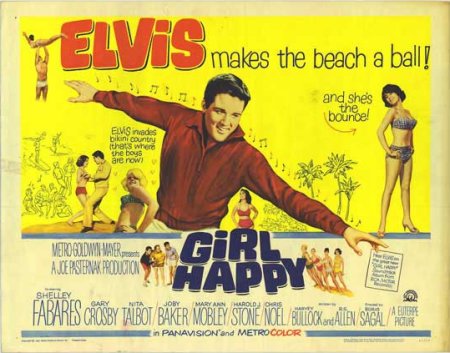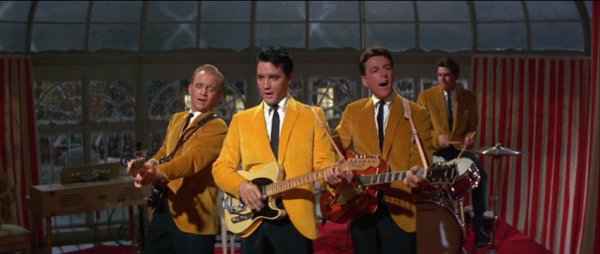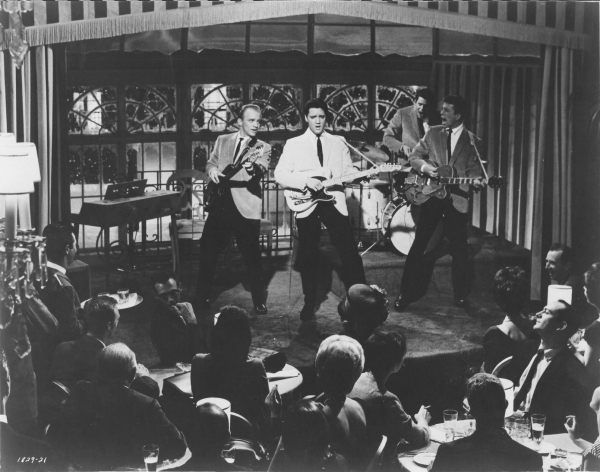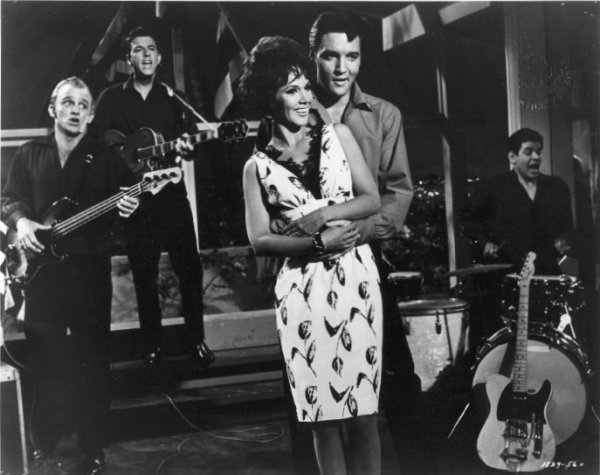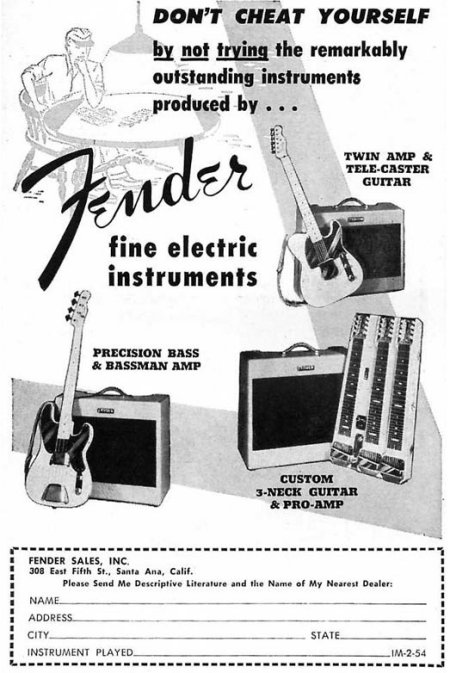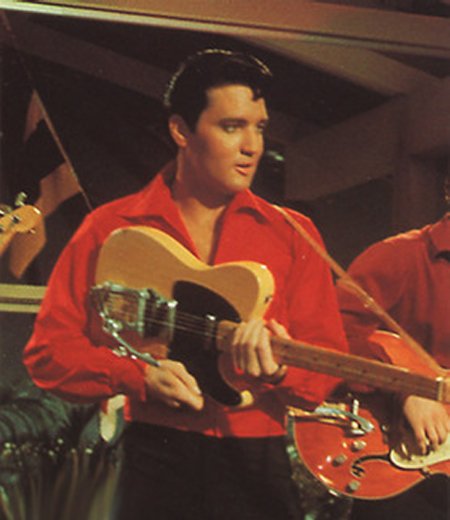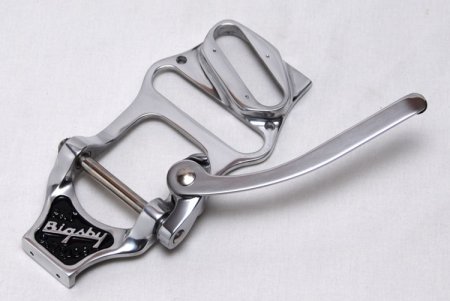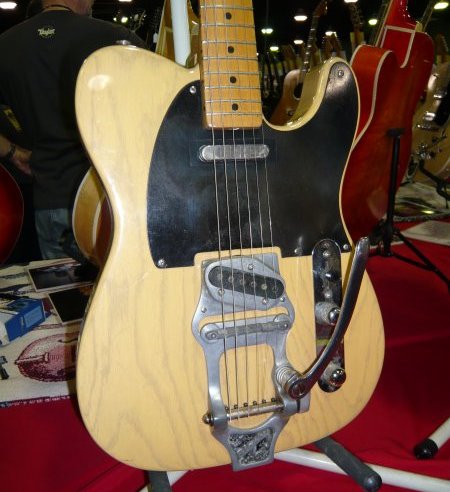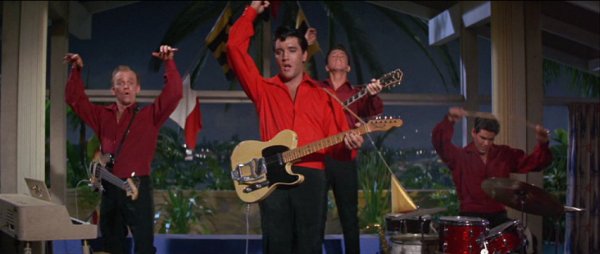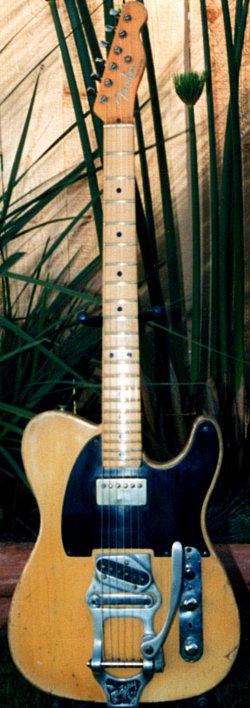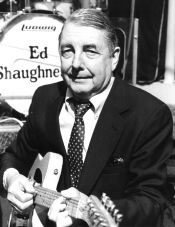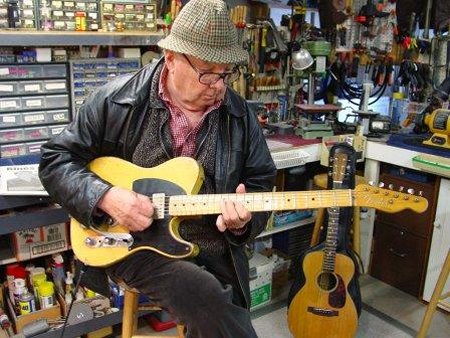 |
1950s Fender Telecaster
Set mainly in Ft. Lauderdale Florida around Spring break/Easter vacation, Elvis' seventeenth movie, MGM's 1965 release of Girl Happy has Elvis in the role of a musician fronting a band on screen for the first time since G.I. Blues. His bandmates for this picture were Gary Crosby, the eldest son of Bing Crosby, Jimmy Hawkins and Joby Baker.*
The opening setting is a club in Chicago where the band is completing their final performance and convincing the owner, Big Frank (Harold J. Stone), to expense a trip under the guise of overseeing/protecting the over-protective owner's daughter played by Shelley Fabares, unbeknownst to her, during her vacation in Ft. Lauderdale. This was the first of three Elvis movies that would feature Shelley. She, along with Jimmy Hawkins, her onscreen boyfriend from The Donna Reed Show, would both return the following year in MGM's Spinout. The film also featured Mary Ann Mobley in her first film, in competition with Shelley as Elvis' love interest. She would also return as the love interest in Elvis' next movie, Harum Scarum.*
Aside from one scene where Elvis is again playing the prop dept.'s Gibson LG-1, in this role as a musician/singer Elvis primarily plays a Fender Telecaster, and interestingly enough this is probably the first an only movie where he is shown performing with electric instruments that are "visually" plugged in. This particular instrument is an early 1950s "black guard" Telecaster finished in Butterscotch blond and modified with a Bigsby B16 vibrato tailpiece.
Leo Fender introduced the Fender Telecaster in 1950 as what is considered to be the first solid body electric guitar to go into major production and revolutionized the industry. Initially conceived and designed in 1949 as a one-pickup model called the Esquire, it went into full production in its two-pickup configuration originally named the Fender Broadcaster. It featured a solid ash body with a 25.5" scale length 21 fret 7.25" radius bolt-on maple neck, single coil bridge and neck position pickups, volume and tone control and 3-way switch. Shortly after, the single pickup Esquire was reintroduced at a lower price. At the time Gretsch had a drum line out called the Broadkaster, albeit different spelling, so Fender renamed their guitar the Telecaster and it was one of Scotty's first guitars coming out of the NavyNot wanting to waste decals there were a small number of guitars released in the interim with the "Broadcaster" portion cut out and named simply "Fender" on the headstocks. These rare instruments are referred to as "Nocasters."
Until around 1954 when the Stratocaster was introduced with white polystyrene plastic guards, the Telecaster pick guards were made of black bakelite. Noted for its twang and often referred to simply as a Tele, they are well established and extremely popular with many players in country music. It was/is the instrument of choice for many other players as well, including James Burton who would become synonymous with Fender's paisley model during the years he performed as lead guitarist in Elvis' TCB band, from 1969 to Elvis' death in 1977.
Traditionally, the '50s Telecaster bridge is a steel rectangular ashtray type design with three individual height adjusting brass saddles with approximating intonation. The strings are anchored from the back of the body, load through it and across the saddles in the bridge. With a modified B16 vibrato tailpiece designed specifically for the Telecaster, the strings anchor at the bar at the end of the tailpiece and tighten or loosen when the bar rolls as the lever is pulled or pressed.
Paul Bigsby, who had built some of the first solid body guitars in limited numbers for Merle Travis and others in the '40s and who designed vibrato tailpieces for many guitars, made the B16 model specifically for the Fender Telecaster in the 1950's. Initially the model was aluminum with a nickel finish and has a separate compensated height adjustable bridge. With a built in bridge pickup ring that normally sits higher than a pickup mounted in a conventional Telecaster bridge, the angle/pitch of the neck has to be adjusted to compensate.
Today, Fender Musical Instruments Corporation still produces the Telecaster and now offers it in several versions, including vintage reissues of the '50s models, Custom Shop Broadcaster and Nocaster models in addition to a James Burton signature series and many others.
Coincidentally, also starring in Girl Happy was actor Jackie Coogan in the role of a police sergeant who starred as Uncle Fester in The Addams family on television, which also starred Carolyn Jones, who costarred with Elvis in King Creole. Another coincidence, albeit tragic, was that the film was directed by Boris Sagal who also directed episodes of Combat! on television that starred Vic Morrow, another of Elvis' costars from King Creole. Both Boris and Vic would share separate, similar fates with accidental deaths involving a helicopter. This page added August 15, 2010 is part of the section The Movie Guitars of Elvis Presley. FENDER®, STRATOCASTER®, STRAT®, TELECASTER®, TELE®, P BASS®, PRECISION BASS®, and the distinctive headstock designs of these guitars are registered trademarks of Fender Musical Instruments Corporation.
Bob Bain's 1953 Telecaster
Recently, Vintage Guitar magazine, in their May 2012 issue, published an interview with legendary musician and sessionist Bob Bain. On the cover was a picture of his 1953 Telecaster and the first thing that jumped out at me was the Bigsby B-16 it was equipped with. Reading more I discovered that it was a favorite session guitar of his and that Tiny Timbrell had worked on it. Tiny played on more than a few of Elvis' films beginning with Loving You, was the West Coast Gibson rep, in addition to selling and servicing instruments at Fife & Nichols' Hollywood store. I knew that Bob had done session work with Elvis, as early as Girls Girls Girls in 1962, probably earlier at Fox and on his last feature film Change of Habit at least, and I began to wonder if the guitar might have in fact been the one used by Elvis in Girl Happy. It's rare to see a 1953 Tele with a B-16 and the other associations just seemed conveniently coincidental.
Bob had been one of the sought after people for sessions and had started in the days of big bands when guitarists were relegated to playing rhythm. He had played on almost every early recording of Frank Sinatra's and only stopped because he was so busy it would've have been cost prohibitive to tour with him. His main guitar used for sessions was his 1953 Tele. It was the guitar used for the Peter Gunn theme, and Batman, the Pink Panther and The Munsters, to name just a few.
The big difference between Bob's and the one Elvis used was that Bob's had been modified with a
humbucker pick-up in the neck position. In VG's interview Bob said ," As luck would have it, Tiny's son Jay has recently been
going through a lot of his father's old things and cataloging a lot of
his guitars, records,
photos and parts. In doing he found what is most likely the
original bridge from Bob's Tele along with the neck pickup he replaced
with a humbucker. The Bigsby bridge came with the original
instructions and a set of strings.
John contacted Tracy Longo, at
Guitar Tech
Corner (GTC), who has been Bob's guitar tech for almost 19 years and he put in a call to Bob.
Tracy said, Bob said Elvis' prop or not, Bob's Tele is one
cool guitar with one heck of a history!
added March 16, 2012
Special thanks to John Jorgensen, Tracy Longo, John B.
Field and
especially Bob Bain for their assistance with this addition.
Read more about Bob on
Classic Jazz Guitar and
|
|||
|
All photos on this page unless otherwise indicated are the property of the designated persons or company, any unauthorized use or reproduction is prohibited. |
